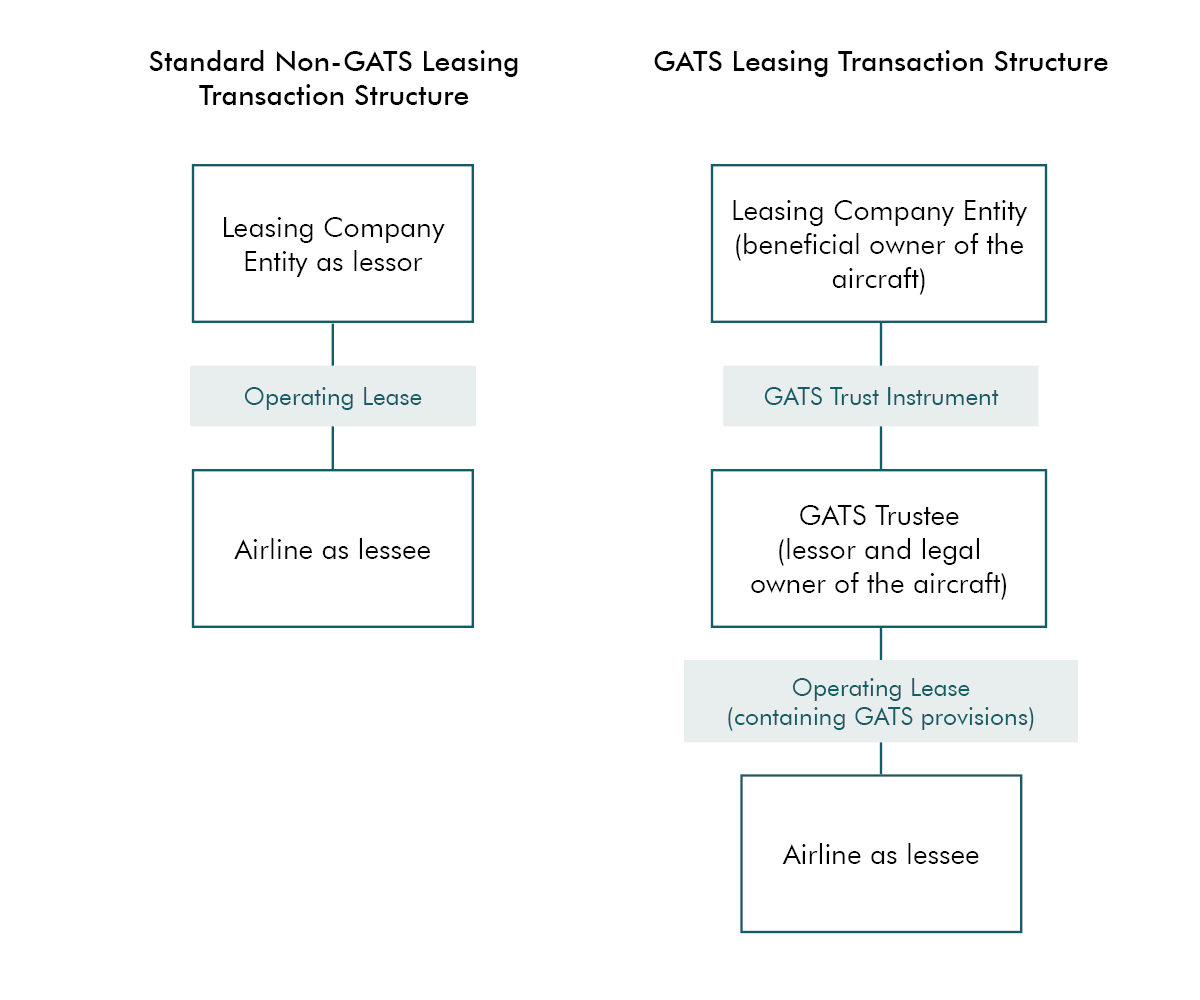Partner Singapore
"With aircraft trading and operating lease transactions post Covid-19 having returned to the market in significant numbers, now is the perfect time for industry participants to revisit GATS."
Introduction
GATS launched in the third quarter of 2019 to much interest and enthusiasm from the aircraft leasing industry. Aircraft trading had grown exponentially, but the methods for executing aircraft sales, and with them the transfer of the airline leases attached to them, had not progressed much from the early days of smaller aircraft trade transactions and lower annual volumes. GATS established a secure, live and searchable electronic ledger where aircraft ownership, certain security interests and trades could be searched and recorded. Two of GATS’ main objectives are to:
- Protect and enhance the rights of the airline under the lease in an aircraft trade:
Confirmation through the GATS platform from the airline to any trade that all of the requirements to such transfer contained in the lease have been met. Without such confirmation, the GATS platform technologically blocks the transfer from taking effect; and - Drive efficiencies in the trading process:
The old system (which largely remains current) of transfer and novation agreements to transfer a lease agreement between the seller and purchaser of an aircraft can be inefficient and time consuming, diverting the airline’s resources away from its core business. More broadly, greater efficiency will lead to more liquidity in aircraft trading, which in turn will benefit airlines as supply increases and cost savings are made.
Are Airlines Resistant to GATS?
"The structure of a GATS transaction is based on a legal owner/beneficial owner structure which has been used in many aircraft leasing transactions, in many jurisdictions and over many years and is therefore tried, tested and established."
Although GATS has been developed by the leasing companies, it has been embraced by many airlines, but not as many as expected. Whilst a global pandemic is never well timed, the timing was particularity unfortunate for GATS as Covid-19 materialised soon after its launch, which resulted in a collapse in aircraft trading and a loss of momentum. Consequently, as focus during the pandemic shifted away from aircraft trading, it also necessarily shifted away from GATS. With fewer transactions in the market, leasing companies found themselves competing harder than ever for airline business. GATS became a secondary priority.
With aircraft trading and operating lease transactions post Covid-19 having returned to the market in significant numbers, now is the perfect time for industry participants to revisit GATS. In this article, we review GATS from the airline’s perspective, why airlines would save money and resources by leasing their aircraft in a GATS structure and how GATS protects the rights and interests of the airlines.
The GATS Structure
The structure of a GATS transaction is based on a legal owner/beneficial owner structure which has been used in many aircraft leasing transactions, in many jurisdictions and over many years and is therefore tried, tested and established. Even outside GATS, trading aircraft using owner trusts is simplified. GATS builds on and ‘turbo-charges’ the owner trust structure, using the beneficial interest transfer as a foundation for making transfers even more efficient by (1) using standard form documentation for the GATS trust instrument and transfer instrument; (2) requiring all such documents to be executed electronically on the GATS platform; a (3) recording all beneficial interest transfers on the (searchable) GATS ledger; and (4) providing for (optional) additional provisions to be inserted into the transfer clause of the lease to allow for a more streamlined trade of the aircraft without compromising, and indeed enhancing, the rights of the airline, as explained above. The following diagrams show the difference between a standard non-GATS structure and a GATS structure:
In a GATS transaction, bare legal title to the aircraft is held in a trust by a professional trustee (which has been approved to act as a GATS trustee) with all of the beneficial and economic interest in the aircraft being held by the lessor entity who, but for the owner trust structure (as depicted on the left), who would typically have been the lessor and would have held both legal and beneficial title to the aircraft. The arrangement between the GATS trustee, as legal owner, and the leasing company, as GATS beneficiary, is established pursuant to the GATS trust instrument, which is standard form and is executed electronically through the GATS platform. Notwithstanding the interposing of the GATS trustee as the lessor, the airline will continue to deal with the leasing company as it would in a standard transaction. Generally speaking, the GATS trustee cannot exercise lessor rights or discretions under the lease without the consent of the leasing company, and similarly the GATS trustee will exercise such rights at the direction of the leasing company.
Trading in a standard structure
"When an aircraft is traded in the standard transaction, the lessor transfers legal and beneficial title to the aircraft to the new owner and the lease is transferred or novated to the new owner or an intermediate lessor."
When an aircraft is traded in the standard transaction, the lessor transfers legal and beneficial title to the aircraft to the new owner and the lease is transferred or novated to the new owner or an intermediate lessor. This causes an administrative burden for the airline, including:
- in all cases a transfer/novation agreement needs to be negotiated and entered into by the existing lessor, the airline and the new lessor. The airline is required to commit resources to this process;
- the airline is usually required to make and repeat certain representations and warranties in the transfer/novation agreement which creates risk for the airline;
- the airline is required to re-issue conditions precedent documents, such as board resolutions, certificates, deregistration powers of attorney and air traffic control letters. This requires director management time and more airline resource to process the documents; and
- in many cases the legal owner of the aircraft is named on the aircraft certificate of registration or recorded with the aviation authority. The airline is required to process the change in ownership with the aviation authority which is burdensome. It is not unusual that the aircraft may have to be grounded at some point during this process causing operational disruption.
Airlines usually need to commit significant resource to the negotiation of the novation agreement and associated documentation which diverts resources away from the airline’s core business.
Trading in a GATS structure
In a GATS structure, to trade the aircraft, the selling leasing company entity – the existing GATS beneficiary – executes electronically through the GATS platform a beneficial transfer instrument. Thereby transferring its beneficial interest in the GATS trust (established pursuant to the GATS trust instrument) to the buying leasing company entity, the new GATS beneficiary. Only the beneficial ownership of the aircraft changes, the GATS trustee and lessor under the lease remains the same, with legal title also remaining with it. This benefits the airline significantly as:
- there is no requirement for a novation/transfer agreement. This reduces the resources which the airline is required to commit to the transaction and, depending on how the lease is drafted, eliminates or reduces the typical representations and warranties given in a novation;
- if the template transfer provisions have been adopted in full in the lease agreement, the airline is required to reissue very few condition precedent documents, alleviating demand on the airline’s resources; and
- the legal owner of aircraft does not change and, in jurisdictions which record the legal owner either on the certificate of registration, with the aviation authority or in some other public register, there will be no need to update the identity of the legal owner on such certificate or with such authority or registry.
How are the rights of Airlines Protected in a GATS Transaction?
Advantages for Airlines
"GATS transforms the airline’s role in an aircraft trade such that it can be completed with a few clicks of a button, with the same protections but with enhanced rights through the ‘advance requirement’ functionality."
Any airline which signs up to GATS should become familiar with how the system works fairly quickly as the look and feel is similar to the International Registry. Upon entering into the lease, an airline employee or representative, will be able to ’upload’ to the GATS platform the relevant transfer requirements contained in the lease (called ‘advance requirements’ on the platform). These requirements are typically negotiated to be functionally equivalent to the requirements for an absolute transfer in a standard structure. Examples of such requirements might be a ‘no increased obligations’ requirement, or that the transfer must not be to a competitor airline. All advance requirements on the GATS platform are encrypted and remains confidential between the airline, the GATS trustee and the leasing company (as GATS beneficiary). Like in a standard structure, such requirements are principally documented as transfer requirements for the benefit of the airline in the lease. GATS provides an enhanced version of the same protections, as the platform will not allow a trade on the platform to take effect unless and until the airline has confirmed that all advance requirements relating to such trade have been satisfied or waived. Furthermore, if the optional GATS transfer provisions have been incorporated in full, ancillary documentation relating to such trade will be significantly reduced.
Disadvantages for Airlines
There are very few disadvantages to airlines. Some airlines have been reluctant to embrace GATS because the system is new and requires their personnel to gain familiarity with it. However, the interface is easy to use and requires only a minimal investment of time, especially when weighed against the advantages of it. Other airlines have been focussed on more pressing matters during the pandemic as passenger numbers dropped considerably but may well take another look at GATS now that recovery is well on the way at which point the benefits of the system may become much clearer.
Conclusion
In the era of blockchain technology, trading leased aircraft using a novation agreement seems anachronistic. GATS brings aircraft trading into the modern era. It seems odd that as airlines and OEMs, along with other industry participants, push the technological envelope on the metal and other parts of the industry ecosystem, the leasing and legal industry continues to use novation technology which is decades old and has barely changed since its first development. GATS transforms the airline’s role in an aircraft trade such that it can be completed with a few clicks of a button, with the same protections but with enhanced rights through the ‘advance requirement’ functionality. The time and resources saved through GATS could be deployed by the airline back into its core business of air transport.
Over the next few months WFW plans to work with legal professionals in specific jurisdictions to provide more detail on GATS from a local law context. Having been responsible for drafting the standard form documentation and steering the development of the platform, WFW are GATS experts. If you are interested in hearing more how GATS can drive savings in your business, please contact your WFW lawyer.

